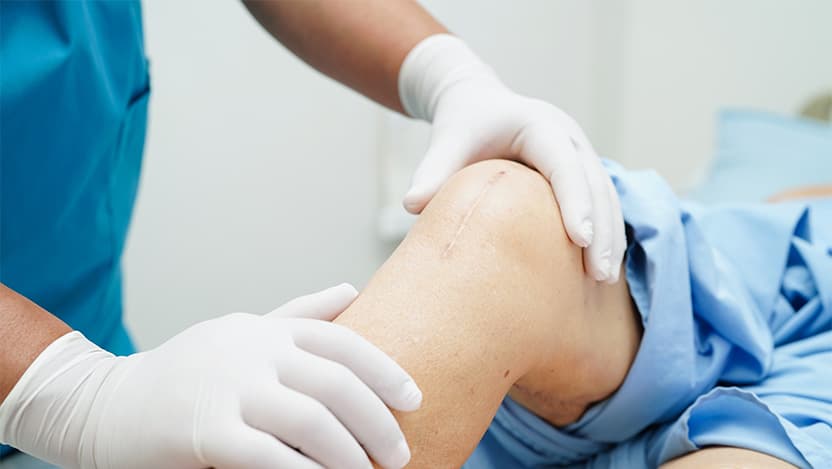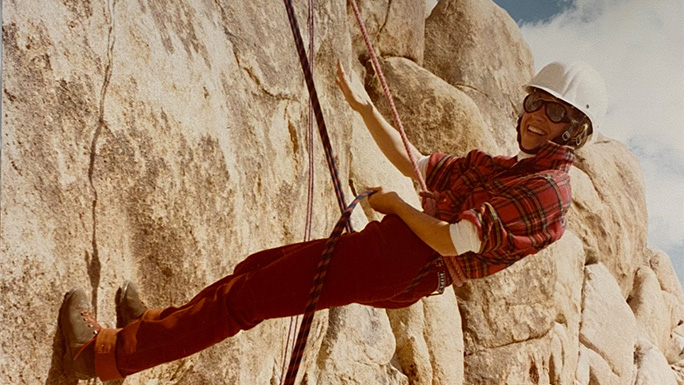Three months after knee replacement surgery, 77-year-old woman resumes hiking

Patients in their 70s often take a little longer to recover from joint replacement surgery, but not Jil Coolidge.
The artist-adventurer, 77, underwent knee replacement surgery at University of Chicago Medicine in late January 2023. By April, Coolidge was hiking in the mountains near her home in Silicon Valley, California.
Not long after, she resumed more intensive hobbies: mountaineering, biking, water skiing and snow skiing.
Several factors led to her quick recovery, said Coolidge’s UChicago Medicine orthopaedic surgeon, Sara Shippee Wallace, MD, MPH.
First, Coolidge was in excellent health and very active before her surgery. That plays a big role in recovery, Wallace said.
Also, Coolidge scheduled her knee replacement surgery preemptively before the pain became debilitating. She also chose UChicago Medicine, which provides some of the most innovative technology available for knee replacements.
“Often, when a patient has problems with their knee for a long period of time, it’s hard for them to get back to various exercises they did, say, 10 years ago,” Wallace said. “But Jil was able to make an unusually fast recovery.”
‘OK, it’s time’

About 10 years ago, shortly after she summitted Mount Whitney, California’s highest mountain, Coolidge noticed her right knee hurt while trekking downhill on her regular 4- to 10-mile hikes.
Her doctor gave her an occasional cortisone shot to ease the pain, but the relief was temporary. Between the wear and tear she’d put on her knee over the years, and the arthritis in her knee joint, Coolidge knew she’d eventually need knee replacement surgery. The arthritis caused a loss of cartilage on her knee, creating joint pain and dysfunction.
“When it really started to become painful, I said, ‘OK, it’s time,’” Coolidge said. “I thought, I’ve gone and shown myself what I’m capable of. Now I need to find a way to continue to do a lot of these things I love.
“I’d invariably end up, toward the end of the day, saying, ‘I don’t like living this way, with all this pain. I want to live the way I used to live.’”
Coolidge interviewed five orthopaedic surgeons around the country, including Wallace, who was recommended by her son-in-law, Ross Coolidge, DO, a physician at Silver Cross Hospital in New Lenox. Wallace is married to Ross’s medical school roommate.
Coolidge preferred a female physician. She was convinced Wallace was the right choice based on her expertise, personality and willingness to take time with her.
“I talked to so many different doctors, but I was impressed that UChicago Medicine was at the forefront of everything new that is happening,” she said.
Mimicking the natural knee joint
At UChicago Medicine, Coolidge’s knee would be replaced with a medial congruent bearing — a state-of-the-art bearing for a specific knee joint. By mimicking the anatomical design and native kinematics of the natural knee joint, the implant functions like a typical knee does.
“I use it in the majority of my patients, but it’s a choice made by the surgeon,” Wallace said. “It’s newer design technology and it mirrors the way the knee was meant to work.”
The surgery she recommended for Coolidge — a total knee arthroplasty — uses metal caps to resurface the ends of the knee bone where the cartilage deteriorated. A plastic bearing is then fitted between those two metal pieces, allowing for smooth and pain-free motion.
Coolidge’s age didn’t factor into the decision because Wallace wants every patient to have the most functional knee possible, whether it’s for 10 years or 50 years.
“I want them to have the best knee on the market, done the best way possible," she said.
The surgery is minimally invasive, meaning Coolidge could recover and rehabilitate at her daughter and son-in-law’s home in the south suburbs. That was a big plus for Coolidge, as her husband, Oliver, is a pilot and travels often for work.
Coolidge ultimately chose UChicago Medicine in Hyde Park for her surgery.
“They did a beautiful job,” Coolidge said.
Team approach to recovery
In recent years, UChicago Medicine has developed an integrated, multidisciplinary approach for joint replacements. Hospitalists and internal medicine doctors help prepare patients for surgery to ensure the procedure goes smoothly.
Additionally, physical therapists schedule postsurgical visits in advance. They also meet patients in the surgery recovery area to help get them up and moving right away.
“We have a whole team of orthopedic providers now who specialize in joint replacement who are available to patients,” Wallace said. “They deliver total joint education class before the surgery and are available by phone after the surgery.
“We have a great group of people from all disciplines working together to ensure that no patient falls through the cracks and everyone has a positive experience.”
This type of expertise is in demand, as knee replacements — and joint replacements in general — are skyrocketing in the U.S. Between 2018 and 2030, total knee replacement surgeries are projected to grow 673%, to 3.5 million procedures per year, according to the American Association of Hip and Knee Surgeons.
Wallace attributes part of this increase to the obesity epidemic, since added weight wears down knee cartilage faster. But it’s also because people are living longer and lead more active lives, she said.
Back on the trail
For about a week after her surgery, Coolidge relied on a walker to get around and took pain medication, mostly for sleeping, she said. The physical therapist who came to their house was awed by her swift recovery and repeatedly reminded her to take it slow.
A lifelong athlete, Coolidge was anxious to push herself with the muscle-building exercise and walks, even in the snow.
Day after day, she felt stronger and her knee became more stable. After about a month, she returned home to California and soon found herself back on her favorite hiking trails.
“I like to get a good workout and feel exhausted. It makes me feel alive,” said Coolidge, who also creates large-scale oil paintings.
Wallace said it’s rare to see a patient that age achieve such a high level of function after surgery.
Still, she said, “if you’re strong, moving and exercising going into the surgery, you’re going to recover much more quickly. And Jil is certainly evidence of that.”

Sara Wallace, MD
Sara Wallace, MD, is an orthopaedic surgeon who specializes in joint care. Dr. Wallace treats a wide range of common and complex hip and knee conditions, performing surgical procedures to restore mobility and reduce joint pain.
Learn more about Dr. WallaceOrthopaedic Knee Care
The orthopaedic specialists at the University of Chicago Medicine offer comprehensive non-operative, arthroscopic and joint replacement care for patients with knee injuries and knee pain.
Explore our knee services